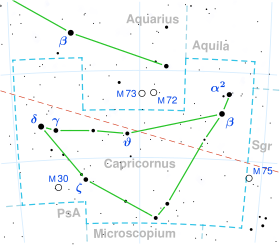Kappa Capricorni
| Observation data Epoch J2000.0 Equinox J2000.0 (ICRS) | |
|---|---|
| Constellation | Capricornus |
| Right ascension | 21h 42m 39.50710s[1] |
| Declination | −18° 51′ 58.7669″[1] |
| Apparent magnitude (V) | +4.73[2] |
| Characteristics | |
| Spectral type | G8 III[3] |
| U−B color index | +0.51[2] |
| B−V color index | +0.88[2] |
| Astrometry | |
| Radial velocity (Rv) | −2.87±0.18[4] km/s |
| Proper motion (μ) | RA: +145.85[1] mas/yr Dec.: −9.50[1] mas/yr |
| Parallax (π) | 11.09 ± 0.28 mas[1] |
| Distance | 294 ± 7 ly (90 ± 2 pc) |
| Absolute magnitude (MV) | −0.023[5] |
| Details[6] | |
| Mass | 2.43±0.21 M☉ |
| Radius | 13.28±0.47 R☉ |
| Luminosity | 106.8±5.9 L☉ |
| Surface gravity (log g) | 2.59±0.06 cgs |
| Temperature | 5,096±57 K |
| Metallicity [Fe/H] | −0.39±0.10 dex |
| Rotational velocity (v sin i) | 0.0[4] km/s |
| Age | 1.19[7] Gyr |
| Other designations | |
| Database references | |
| SIMBAD | data |
Kappa Capricorni (κ Cap, κ Capricorni) is a solitary[9] star in the constellation Capricornus. It is visible to the naked eye with an apparent visual magnitude of +4.73.[2] Based upon an annual parallax shift of 11.09 mas as seen from the Earth,[1] the star is located about 294 light years from the Sun.
This is a yellow-hued, evolved, G-type giant star with a stellar classification of G8 III.[3] There is a 91% probability that it is currently on the horizontal branch, rather than the red giant branch.[6] As such, it is a red clump[10] giant with an estimated 2.43 times the mass of the Sun and has expanded to 13.28 times the radius of the Sun.[6] The star is about 1.2[7] billion years old and has a projected rotational velocity that is too small to be measured.[4] It radiates 107 times the solar luminosity from its photosphere at an effective temperature of 5,096 K.[6]
References
- ^ a b c d e f van Leeuwen, F. (2007), "Validation of the new Hipparcos reduction", Astronomy and Astrophysics, 474 (2): 653–664, arXiv:0708.1752, Bibcode:2007A&A...474..653V, doi:10.1051/0004-6361:20078357.
- ^ a b c d Johnson, H. L.; et al. (1966), "UBVRIJKL photometry of the bright stars", Communications of the Lunar and Planetary Laboratory, 4 (99), Bibcode:1966CoLPL...4...99J.
- ^ a b Houk, N.; Smith-Moore, M. (1988), Michigan Catalogue of Two-dimensional Spectral Types for the HD Stars, vol. 4, Bibcode:1988mcts.book.....H.
- ^ a b c Massarotti, Alessandro; et al. (January 2008), "Rotational and Radial Velocities for a Sample of 761 HIPPARCOS Giants and the Role of Binarity", The Astronomical Journal, 135 (1): 209–231, Bibcode:2008AJ....135..209M, doi:10.1088/0004-6256/135/1/209.
- ^ Soubiran, C.; et al. (2008), "Vertical distribution of Galactic disk stars. IV. AMR and AVR from clump giants", Astronomy and Astrophysics, 480 (1): 91–101, arXiv:0712.1370, Bibcode:2008A&A...480...91S, doi:10.1051/0004-6361:20078788.
- ^ a b c d Reffert, Sabine; et al. (2015), "Precise radial velocities of giant stars. VII. Occurrence rate of giant extrasolar planets as a function of mass and metallicity", Astronomy and Astrophysics, 574A (2): 116–129, arXiv:1412.4634, Bibcode:2015A&A...574A.116R, doi:10.1051/0004-6361/201322360, hdl:10722/215277. Values are based on 91% probability it is on the horizontal branch.
- ^ a b Luck, R. Earle (2015), "Abundances in the Local Region. I. G and K Giants", The Astronomical Journal, 150 (3): 88, arXiv:1507.01466, Bibcode:2015AJ....150...88L, doi:10.1088/0004-6256/150/3/88.
- ^ "kap Cap". SIMBAD. Centre de données astronomiques de Strasbourg. Retrieved 2017-05-13.
{{cite web}}: CS1 maint: postscript (link) - ^ Eggleton, P. P.; Tokovinin, A. A. (September 2008), "A catalogue of multiplicity among bright stellar systems", Monthly Notices of the Royal Astronomical Society, 389 (2): 869–879, arXiv:0806.2878, Bibcode:2008MNRAS.389..869E, doi:10.1111/j.1365-2966.2008.13596.x.
- ^ Alves, David R. (August 2000), "K-Band Calibration of the Red Clump Luminosity", The Astrophysical Journal, 539 (2): 732–741, arXiv:astro-ph/0003329, Bibcode:2000ApJ...539..732A, doi:10.1086/309278.

